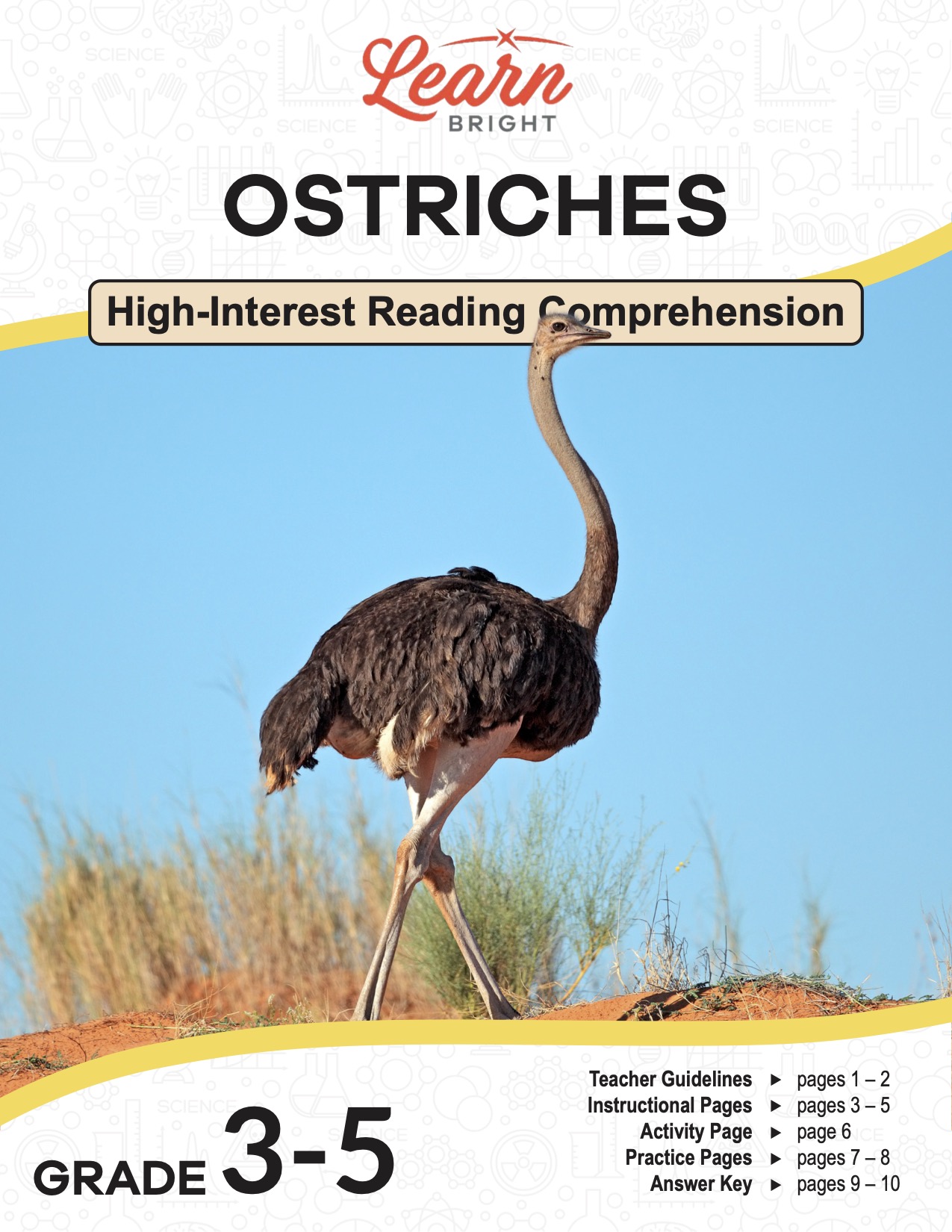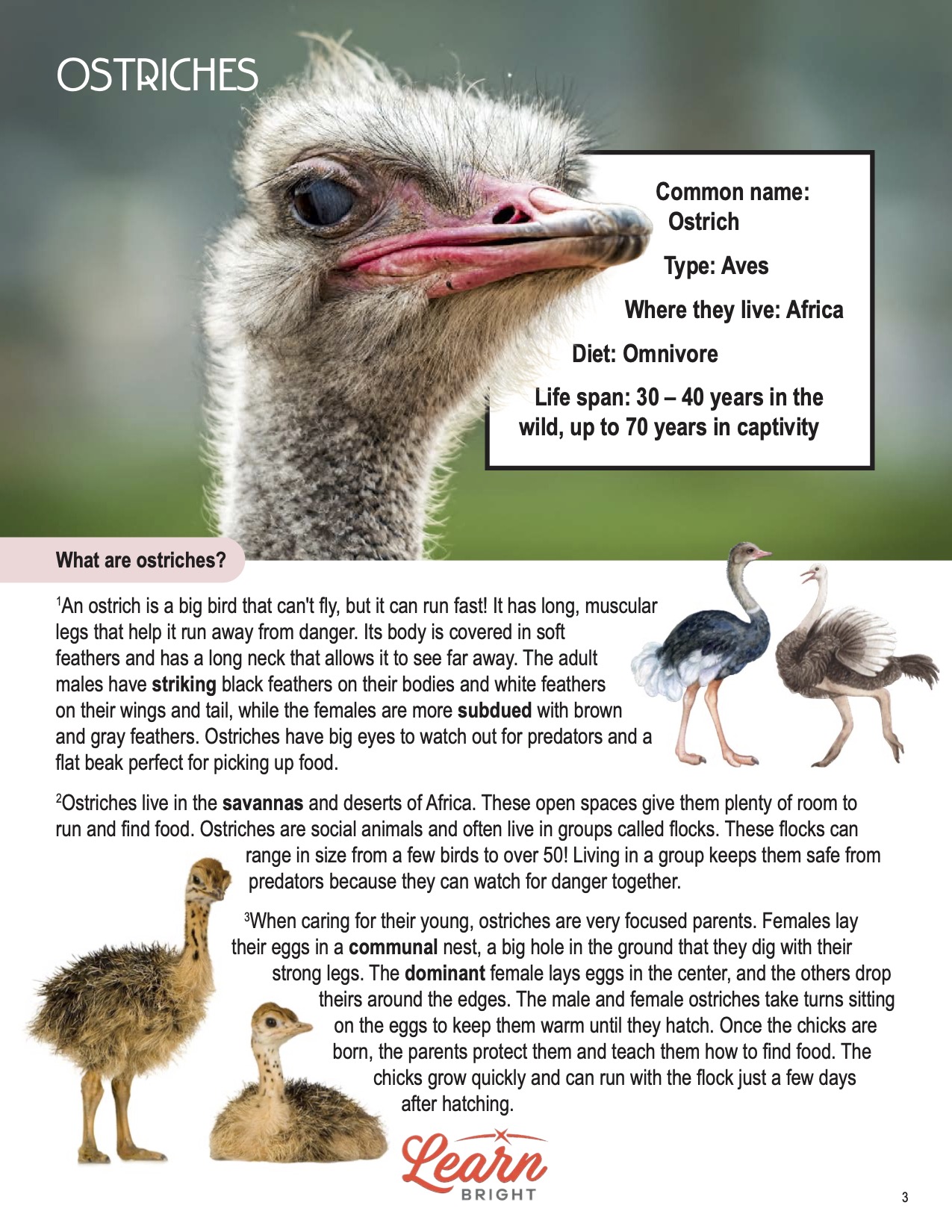Description
What our Ostriches lesson plan includes
Lesson Objectives and Overview: Ostriches is a high-interest reading comprehension lesson plan. As such, students will practice various close reading and comprehension skills. In addition, they will learn about the habitat, diet, and behaviors of this bird. This lesson is for students in 3rd grade, 4th grade, and 5th grade.
Classroom Procedure
Every lesson plan provides you with a classroom procedure page that outlines a step-by-step guide to follow. You do not have to follow the guide exactly. The guide helps you organize the lesson and details when to hand out worksheets. It also lists information in the yellow box that you might find useful. You will find the lesson objectives, state standards, and number of class sessions the lesson should take to complete in this area. In addition, it describes the supplies you will need as well as what and how you need to prepare beforehand. For the activity, you will need acrylic paint, plastic forks, construction paper, glue sticks, scissors, and a fine-tip black marker.
Teacher Notes
The paragraph on this page gives you a little more information on the lesson overall and describes what you may want to focus your teaching on. It explains that you can teach this lesson in a whole-class setting or as an independent, small-group activity. The blank lines are available for you to write out any thoughts or ideas you have as you prepare.
OSTRICHES LESSON PLAN CONTENT PAGES
What Is an Ostrich?
The Ostriches lesson plan contains three content pages. It begins by providing a box of background information about this bird. They live only in Africa (in the wild) and eat both plants and animals. Their life span is quite impressive, as they live around 30 to 40 years in the wild. In captivity, they can live up to 70 years!
An ostrich is a big bird that can’t fly, but it can run fast! It has long, muscular legs that help it run away from danger. Its body is covered in soft feathers and has a long neck that allows it to see far away. The adult males have striking black feathers on their bodies and white feathers on their wings and tail, while the females are more subdued with brown and gray feathers. Ostriches have big eyes to watch out for predators and a flat beak perfect for picking up food.
Ostriches live in the savannas and deserts of Africa. These open spaces give them plenty of room to run and find food. Ostriches are social animals and often live in groups called flocks. These flocks can range in size from a few birds to over 50! Living in a group keeps them safe from predators because they can watch for danger together.
When caring for their young, ostriches are very focused parents. Females lay their eggs in a communal nest, a big hole in the ground that they dig with their strong legs. The dominant female lays eggs in the center, and the others drop theirs around the edges. The male and female ostriches take turns sitting on the eggs to keep them warm until they hatch. Once the chicks are born, the parents protect them and teach them how to find food. The chicks grow quickly and can run with the flock just a few days after hatching.
Diet of an Ostrich
Ostriches are technically omnivores, which means they eat plants and animals, but their diet is 95% plant-based. They mostly eat grasses, seeds, and fruits, but sometimes insects. They use their strong, sharp beaks to peck at plants and pick up small insects. Ostriches also swallow small stones and pebbles, which help them grind up their food in their stomachs since they don’t have teeth to chew.
When ostriches search for food, they use their keen eyesight to spot it from a distance. Their long legs allow them to move quickly across the savanna and cover a lot of ground in a short time. They are also good at running after their food, using their speed to catch insects or quickly snatch up seeds and berries.
Ostriches are the largest birds in the world, standing up to nine feet tall and weighing as much as 300 pounds! They have the largest eyes of any land animal, which are as big as a billiard ball. These large eyes help them see predators from far away in the open savannas. Despite their size, ostriches cannot fly because their wings are too small and not strong enough to lift them up. Instead, they use their wings for balance and for courtship displays.
Other Interesting Ostrich Facts
One of the most fascinating things about ostriches is their incredible speed. They can sprint up to 45 miles per hour, making them the fastest birds on land! This astonishing speed helps them escape from predators, including lions and hyenas. And their strong legs can deliver powerful kicks that can fend off attackers. Ostriches only have two toes on each foot, though, which is a unique trait among birds.
Another interesting fact about these big birds is their ability to adapt to different temperatures. They can withstand hot and cold temperatures because of specialized feathers. Their feathers regulate their body temperature by trapping air close to their bodies, keeping them warm on chilly nights and cool during scorching days. This is called thermoregulation. Ostriches are remarkable birds with unique adaptations that help them thrive in challenging habitats.
Why They Are Important
Ostriches play an essential role in their environment because they help maintain the balance of plant and insect populations. As primarily herbivores, they eat various plants and seeds, which helps control vegetation growth in their habitats. By grazing on grasses and other plants, ostriches prevent any one type of plant from taking over an area, which can keep ecosystems diverse and healthy. Also, ostriches eat insects like locusts, which helps control insect populations that could otherwise damage crops and vegetation.
Currently, ostriches are not considered endangered, but their populations in the wild face threats from habitat loss and human activities. Loss of habitat due to agriculture and urban development reduces the areas where ostriches can live and find food. Sometimes, they are hunted for their meat, feathers, and leather, which puts additional pressure on their populations. Conservation efforts are essential to protect ostriches and ensure they thrive in their natural environments for future generations to enjoy.
OSTRICHES LESSON PLAN WORKSHEETS
The Ostriches lesson plan includes two worksheets: an activity worksheet and a practice worksheet. Each one will help students solidify their grasp of the material they learned throughout the lesson. You can refer to the classroom procedure guidelines to know when to hand out each worksheet.
OSTRICH ART ACTIVITY WORKSHEET
For this activity, students will paint ostriches! They will use the supplies you provide and follow the directions to create ostrich works of art. You can hang students’ finished pieces in the classroom or school hallway!
OSTRICHES PRACTICE WORKSHEET
The practice worksheet lists 10 questions based on the content. These questions all relate to the content pages, so students will need to refer to them often for the answers. In addition, each question provides which reading tool the question corresponds to, such as text feature, vocabulary, or comprehension.
Worksheet Answer Keys
At the end of the lesson plan document is an answer key for the practice worksheet. The correct answers are all in red to make it easier for you to compare them with students’ responses. If you choose to administer the lesson pages to your students via PDF, you will need to save a new file that omits these pages. Otherwise, you can simply print out the applicable pages and keep these as reference for yourself when grading assignments.









